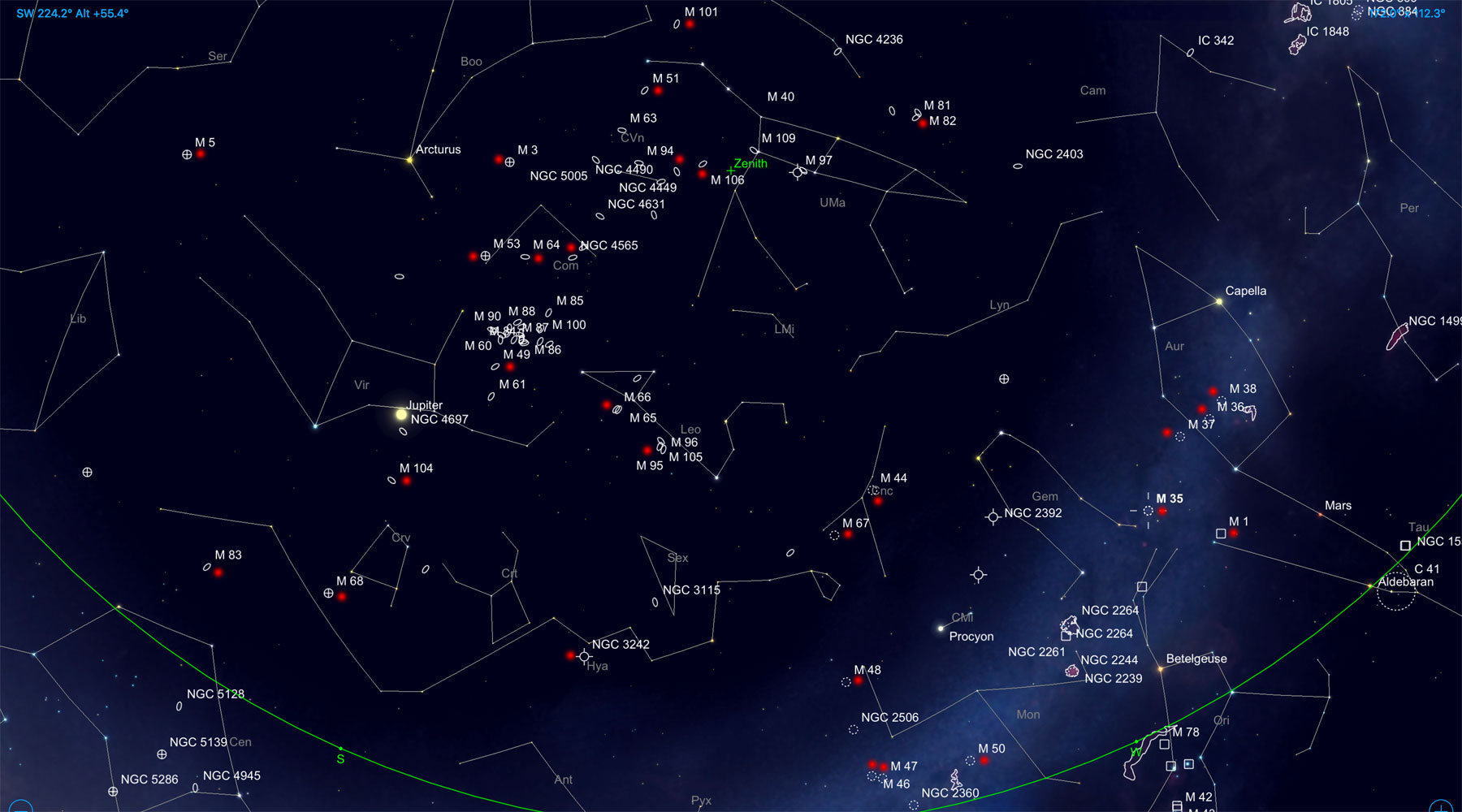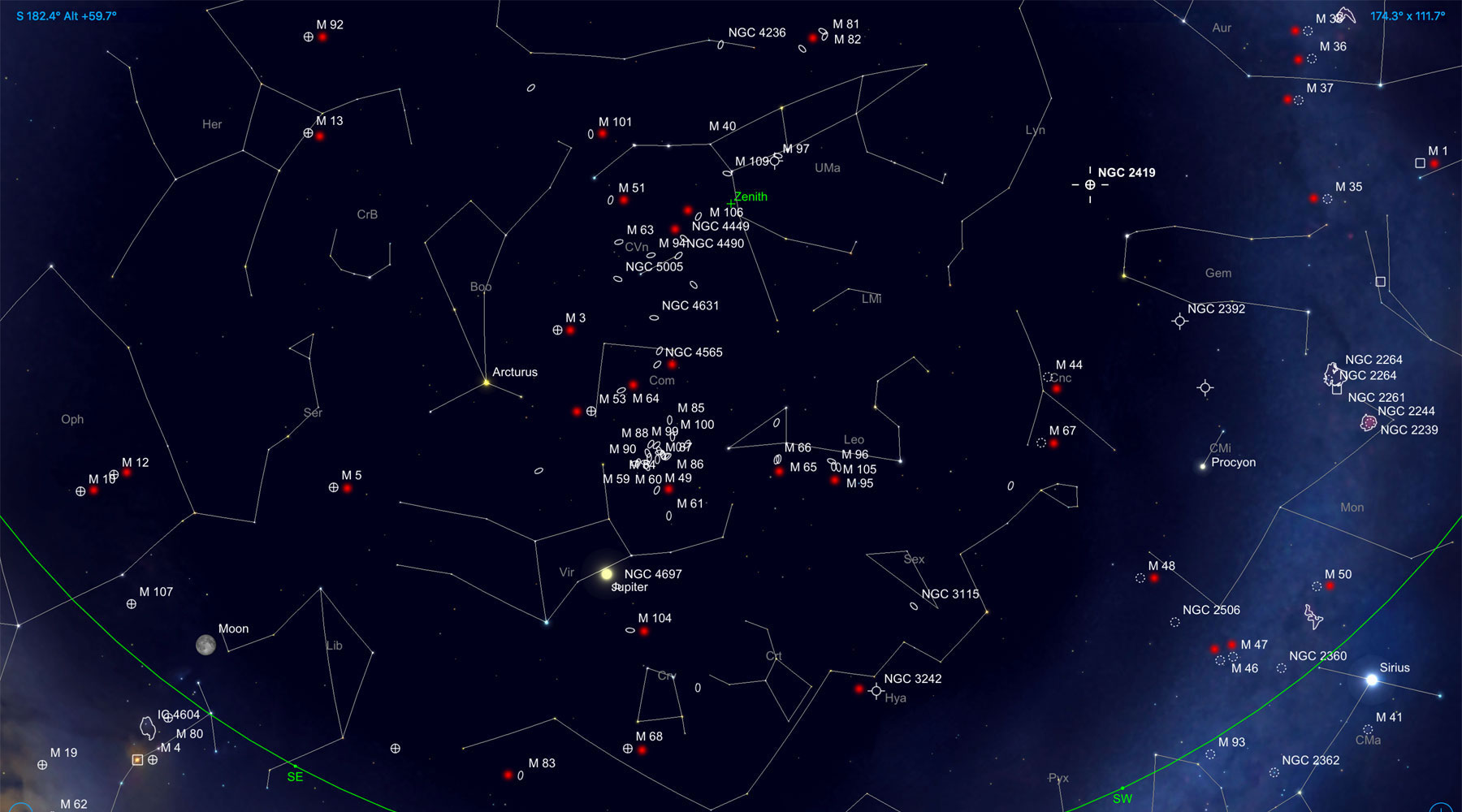Deep Sky Spring/Early Summer Observations May 2017
Observation Conditions | Observation Overview | List of Observed Sky Objects | Remarks | References
From the end of April to the end of May (1st of June, actually...), it is the time for "spring observations", which also comprise some sky objects that might be assigned to early summer and which might be of interest to other beginners and are therefore described here.
Observation Conditions
Sky Region and Objects
I initially restricted myself to the sky region around Ursa Major (Great Bear), Canes Venatici (Hunting Dogs), Gemini (Twins), Coma Berenices (Berenice's Hair), Cancer (Crab), Leo (Lion) because all there were located in about the same direction (Southwest to South). Moreover, I looked to the East in the direction of Hercules.
On my "observation list" there were firstly: M 81/82 (Ursa Major/Great Bear), M 3 (Canes Venatici/Hunting Dogs), M 53 (Coma Berenices/Berenice's Hair), M 35 (Gemini/Twins), M44 and M 67 (Cancer/Crab), as well as M 65/66 and M 96 (Leo/Lion). From May 10 on, I sometimes "drifted" to the East for M 13 und M 92 (Hercules). From mid-May on, I was also able to observe M 5 (Serpens/Serpent). The list of observed objects is, in fact, a little bit longer...
At the end of May, the moon returned to the night sky and made observing deep sky objects increasingly difficult. I then focused on the moon, Jupiter and its moons, the open star cluster in Coma Berenice (Mel 111), and Castor (Gemini/Twins) and Mizar (Ursa Major/Big Dipper) as as double stars. The first of June 2017 was my last observation day in this observation series.
Overview Map
Map, More Oriented Towards the West
The following map is more oriented towards the West. It shows approximately the sky area that I primarily browsed during my observations (the center area is most important here). This map shows better than the following one, which is more oriented towards the East, that many sky objects in the West were rather low on the horizon at this time of the year.
Click the map for a larger version - it opens in a new window. The deep sky objects that I tried to observe (and a few more) are indicated by red dots. (Image Courtesy of SkySafari Astronomy, www.simulationcurriculum.com)
Alternative Map
The following map is more oriented towards the East. It also shows approximately the sky area that I primarily browsed during my observations (the center area is most important here). This map already announces a few "summer sky objects", which I was already able to observe.
Click the map for a larger version - it opens in a new window. The deep sky objects that I tried to observe (and a few more) are indicated by red dots. M 10 and M 12 were not observed. (Image Courtesy of SkySafari Astronomy, www.simulationcurriculum.com)
Observation Time
The observations started every day when it was sufficiently dark, typically only from about 10 p.m. on. Later in May, they started even at 11 p.m. oder later.
Observation Location
All observations were conducted in Mühlhausen/Kraichgau (Germany):
- Coordinates: 49° 15′ N , 8° 43′ E
- Coordinates (dec.): 49,25° N, 8,72° E
Devices Used
- Sky-Watcher Heritage 100P
- Sky-Watcher Explorer 150PDS
- Sky-Watcher Star Discovery AZ GoTo Mount
- Leica Trinovid 10 x 25 binoculars
General Conditions
The first observations took place before the moon was full. Later on, the moon had less and less influence on my observations. From 10 to 12 May, however, the sky was still very bright, so that I was not able to find a lot of targets. Thereafter it became better, but toward the end of May, the moon returned to the night sky, so that hardly any deep sky objects could be found.
In general, the sky above Mühlhausen/Kraichgau is "light-polluted" and does not invite you to search for deep sky objects. This is certainly one of the reasons why I found some of the deep sky objects that I wanted to observe only sometimes or not at all. In May, the days are also very long so that my observations typically started late in the evening (see above).
Observation Overview
| Date 2017 |
Observed Objects | Details, Remarks | Further Observations and Remarks | Devices Used | Eyepieces Used |
| Apr 29 | G: M 65/66, M 96 OC: M 67, M 35 |
Moon and Jupiter were worth-while targets | Crescent of the moon, Jupiter (4 moons, 2 stripes) | Explorer 150PDS on GoTo Mount | 32 mm Plössl, 24 mm WA, 16 mm, 7 mm, and 4 mm UWA, 10 mm WA |
| May 5 | G: M 81/82 OC: M 67, M 44 GC: M 3 |
Moon and Jupiter were worth-while targets, first attempts at globular star clusters | Moon, Jupiter
M 53 not found | ditto | ditto |
| May 9 | OC: M 35 GC: M 3, M 53 |
--- | ditto | ditto | |
| May 10 | KS: M 3, M 53, M 13 | ditto | --- | ditto | ditto |
| May 12 | OC: M 44 GC: M 3, M 13 |
ditto | M 92 not found | ditto | ditto |
| May 14 | G: M 81, M 51, M 64, M 104, M 65/66 OC: M 44, M 67, M 35 GC: M 3, M 5, M 13, M 92, M 53 |
highlight: the globular star clusters M 3, M 5, M 13, and M 92 (7 mm
eyepiece), plus M 53, at about 11:30 p.m. some galaxies "assumed" this time, the sky gets darker each day... |
Jupiter
M 36 and M 38 not, M 37 perhaps seen | ditto | ditto |
| May 15 | G: M 106, M 81/82, M 51, M 64, M 49, M 104, M 65/66 OC: M 44 GC: M 3, M 5, M 13, M 92, M 5 |
probably somewhat darker sky than the day before globular star clusters seen well (24/16 mm) |
Jupiter
M 101 not found | ditto | 24 mm WA, 16 mm, and 7 mm UWA |
| May 16 | G: M 106, M 81/82, M 51, M 64, M 87, M 104 GC: M 3, M 5, M 13, M 92, M 53 |
globular star clusters seen well again (24/4 mm) observing conditions obviously good again and the sky fairly dark at the end of my observations |
Jupiter
M 101 not found | ditto | 24 mm WA, 16 mm, 7 mm, 4 mm UWA (for SC), 10 mm WA |
| May 20 | G: M 106, M 64, M 94, M 104 GC: M 3, M 5, M 13 M 53 |
Jupiter
M 63 not found | ditto | 24 mm WA, 16 mm, 7 mm, and 4 mm UWA | |
| May 23, 24 | OC: Mel 111 | Jupiter | Binoculars, naked eye | ||
| May 26 | OC: Mel 111 GC: M 3
|
Jupiter | Heritage 100P, binoculars, naked eye | 4 mm UWA, further (not documented) | |
| May 29 | DS: Castor | Heritage 100P | 4 mm UWA (100 x), further (not documented) | ||
| May 31 | DS: Castor, Mizar | Jupiter ("3" moons => 2 moons not separable) nearly half moon: beautiful craters at the border between sun and shade |
ditto | ditto | |
| Jun 1 | DS: Castor, Mizar | Jupiter (4 moons, 2 quite close avove each other) nearly half moon: beautiful craters at the border between sun and shade |
ditto | ditto |
Bold: First observation during this observation period; G = galaxy, OC = open star cluster, GC = globular star cluster, DS = double star; all observations done in Mühlhausen/Kraichgau
List of Observed Sky Objects
Object details can be obtained via the links to the relevant deep sky objects.
DSO Details |
Name | Constellation | Type | Bino* | 100P | 150 PDS GT |
Remarks |
| M 81/82 | Bode Galaxy/Cigar Galaxy | Ursa Major | G | yes | two galaxies, the left one oblique and flat, the right one rounder | ||
| zeta UMa | Mizar | Ursa Major | DS | yes | double star; visual double star with Alcor | ||
| Canes Venatici | G | yes | found, weak glow? | ||||
| Canes Venatici | GC | yes | similar to M 5 and M 92, somewhat grainy at higher magnifications | ||||
| Whirlpool Galaxy | Canes Venatici | G | yes | glow (perhaps with brighter core), undefinded something, somewhat larger | |||
| M 94 | Canes Venatici | G | yes | glow | |||
| Coma (Berenices) Star Cluster | Coma Berenices | OC | yes | yes | wide-spread open star cluster with relativly bright stars, best seen with opera glasses; a faint glow with the naked eye | ||
| Blackeye Galay | Coma Berenices | G | yes | glow, but fairly good to see | |||
| Coma Berenices | GC | yes | smallest observed GC, somewhat grainy, brighter core at higher magnifications | ||||
| Virgo | G | yes | small, but seen quite well | ||||
| M 87 | Virgo | G | yes | perhaps a round glow, not much seen | |||
| Sombrero Galaxy | Virgo | G | yes | oblique flat glow, no sombrero... | |||
| Serpens Caput | GC | yes | similar to M 3 and M 92, somewhat grainy at higher magnifications | ||||
| M 44 | Praesepe | Cancer | OC | yes | yes | yes | very nice in binoculars (not documented) |
| M 67 | Cancer | OC | yes | somewhat wide-spread open star cluster | |||
| M 65/66 | Leo | G | yes | sometimes I was able to recognize two galaxies | |||
| M 96 | Leo | G | yes | sometimes I was able to recognize a galaxy, but often not so... | |||
| M 35 | Gemini | OC | yes | very nice OC, fairly large | |||
| alpha Gem | Castor | Gemini | DS | yes | double star | ||
| M 13 | Hercules | GC | yes | yes | yes | largest observed GC, with 4 mm eyepiece (187,5 x) a few stars recognizable, grainy, fairly well resolved into stars | |
| M 92 | Hercules | GC | yes | similar to M 5 and M 5, somewhat grainy at higher magnifications |
*) 10 x 25 binoculars; G = galaxy, OC = open star cluster, GC = globular star cluster, DS = double star
Searched for but not found: M101 (Pinwheel Galaxy), M36, M 37, M 38, M 48, M 50, M 63, M90?, NGC 4449, NGC 4490, NGC 4565
References
Books
- Michael Feiler & Philip Novak (2023). Deep Sky Reiseatlas (5. Auflage), Oculum Verlag (ISBN 978-3-949370-04-5)
www.oculum-verlag.de/detailview?no=608 - Ronald Stoyan (2021). Deep Sky Reiseführer (6. Auflage), Oculum Verlag (ISBN 978-3-938469-72-9)
www.oculum-verlag.de/detailview?no=603 - Erich Karkoschka (2022). Atlas für Himmelsbeobachter, Kosmos Verlag (EAN: 9783440173602)
www.kosmos.de/de/atlas-fur-himmelsbeobachter_1074889_9783440173602
On this Website
- Overview of Observations
- DSO List (Collected from Books)
- Sky-Watcher Heritage 100P Information (4" Dobson)
- Sky-Watcher Explorer 150PDS Information (6" Newton)
- Sky-Watcher Star Discovery AZ GoTo Mount Information
- My Binoculars
| 28.04.2024 |

